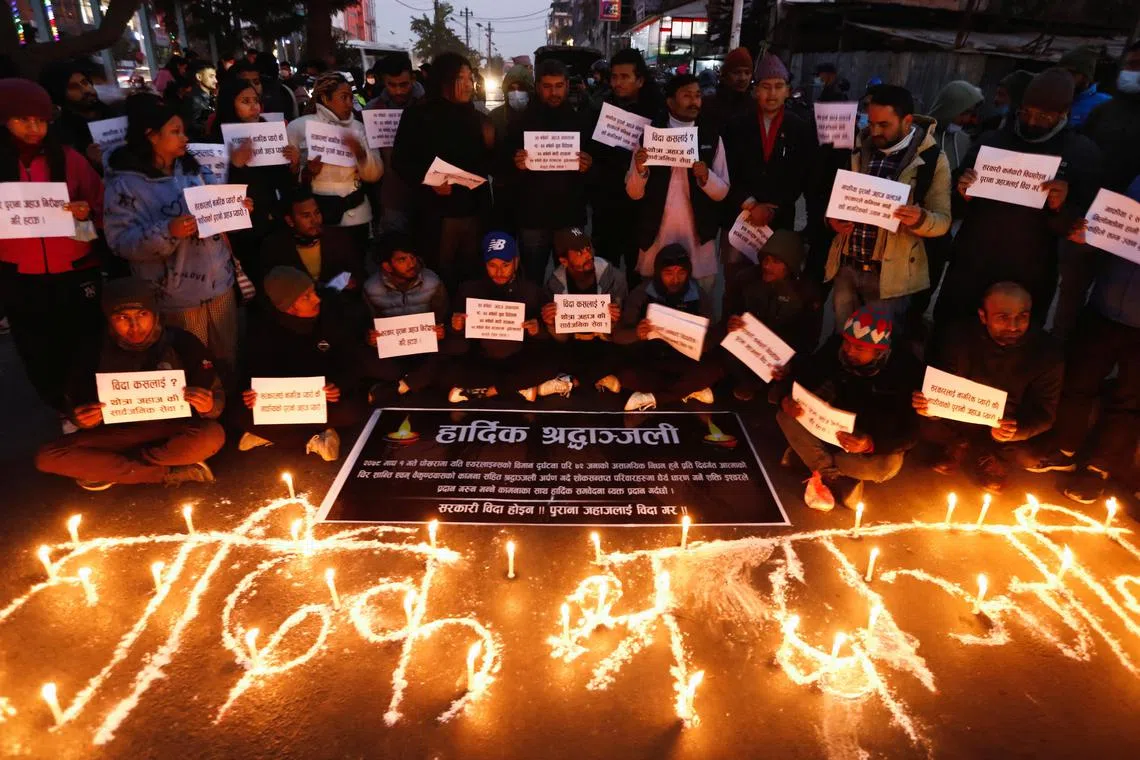Nepal finds black boxes of aircraft after deadliest crash in 30 years
Sign up now: Get insights on Asia's fast-moving developments

Rescuers had recovered 68 bodies out of the 72 people onboard the ATR 72 aircraft operated by Yeti Airlines.
PHOTO: AFP
Follow topic:
KATHMANDU - Searchers found the cockpit voice recorder and flight data recorder on Monday from a passenger flight that crashed on Sunday, killing at least 70 people in Nepal’s worst plane accident in 30 years,
The data on the recorders may help investigators determine what led the Yeti Airlines ATR 72 aircraft carrying 72 people to go down in clear weather, just before landing in the tourist city of Pokhara.
Both recorders were in good shape and will be sent for analysis based on the recommendation of the manufacturer, Kathmandu airport official Teknath Sitaula told Reuters.
Under international aviation rules, the crash investigation agency of the country where the plane was designed and built is automatically part of the inquiry.
ATR is based in France and the plane’s engines were manufactured in Canada by Pratt & Whitney Canada.
Rescuers battled cloudy weather and poor visibility on Monday as they scoured a river gorge for passengers who were unaccounted for, more than 24 hours after the crash.
Two more bodies were recovered on Monday, taking the death toll to 70, said Mr Navin Acharya, an official at the rescue coordination centre at Kathmandu airport.
The search was called off for the remaining two missing people as darkness descended, and will resume on Tuesday, he said.
Pokhara police official Ajay K.C. said all bodies had been sent to a hospital.
In the capital Kathmandu, around 100 people lit candles at a gathering in memory of the crash victims and called on the government to ensure proper safety standards, witnesses said.
Condolences poured in from around the world, including the Vatican.

People hold placards in a condolence meeting following the plane crash of a Yeti Airlines-operated aircraft, on Jan 15 in Kathmandu, Nepal.
PHOTO: REUTERS
“His Holiness Pope Francis sends his condolences to you and to all affected by this tragedy, together with his prayers for those involved in the recovery efforts,” said Cardinal Secretary of State Pietro Parolin in a message to Nepal’s President.
Reuters footage from the crash site showed rescuers looking at the charred remains of the plane near a mountain gorge.
The plane, on a scheduled flight from Kathmandu to Pokhara – gateway to the scenic Annapurna mountain range – was carrying 57 Nepalis, five Indians, four Russians, two South Koreans, and one person each from Argentina, Ireland, Australia and France.
Minutes before the aircraft was to land on Sunday, the pilot asked for a change of runway, a spokesman for Pokhara airport said on Monday. “The permission was granted. “We don’t ask (why), whenever a pilot asks, we give permission to change approach,” said spokesman Anup Joshi.
Sunday’s crash underlined the need for the government to break up the Civil Aviation Authority of Nepal, which both regulates airlines and manages airports, experts said.
“The government must immediately separate the regulatory body and service provider by splitting the Civil Aviation Authority of Nepal which is doing both works now,” aviation expert and retired pilot K.B. Limbu told Reuters.
“This leads to a conflict of interest.”
Asked for comment, Mr Sitaula denied there was any such conflict in the functioning of CAAN.
“The regulatory and service provider (airport management) officials are separate and there is no cross-movement between the two bodies operating under the same organisation,” he said, referring to the CAAN.
There are nine domestic airlines in Nepal, including Yeti Airlines and its unit Tara Air. Yeti and Tara plane crashes have killed at least 165 people in Nepal since 2000, out of a total of 359 dead from aviation accidents, data from the Civil Aviation Authority of Nepal shows.
An additional 75 people have died in helicopter crashes this century in Nepal, which is home to eight of the world’s 14 highest mountains including Everest, and where sudden weather changes can make for hazardous flight conditions.
Experts say air accidents are usually caused by a combination of factors, and investigations can take months or longer.
Ms Anju Khatiwada, the co-pilot of Sunday’s ill-fated aircraft, lost her husband Dipak Pokhrel in a similar crash in 2006. Ms Khatiwada’s remains have not been identified, but she is feared dead.
Nepal observed a day of national mourning on Monday and has set up a panel to investigate the disaster and suggest measures to avoid such incidents in future. REUTERS

